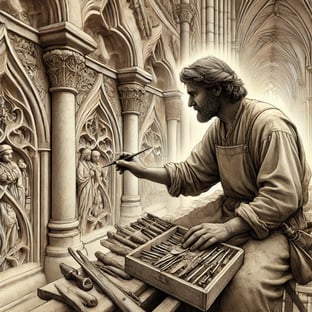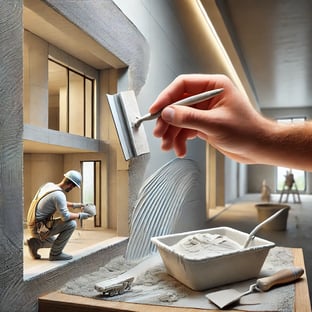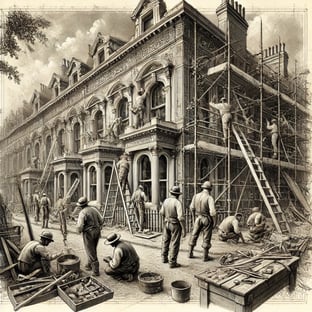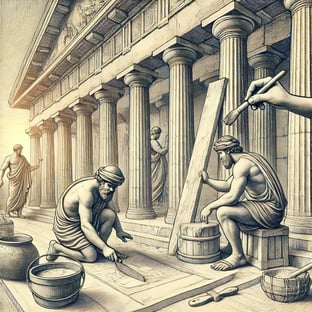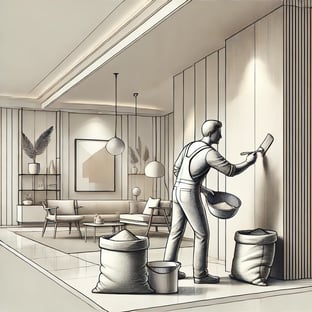Ol&LO, art elevated by MINERAL
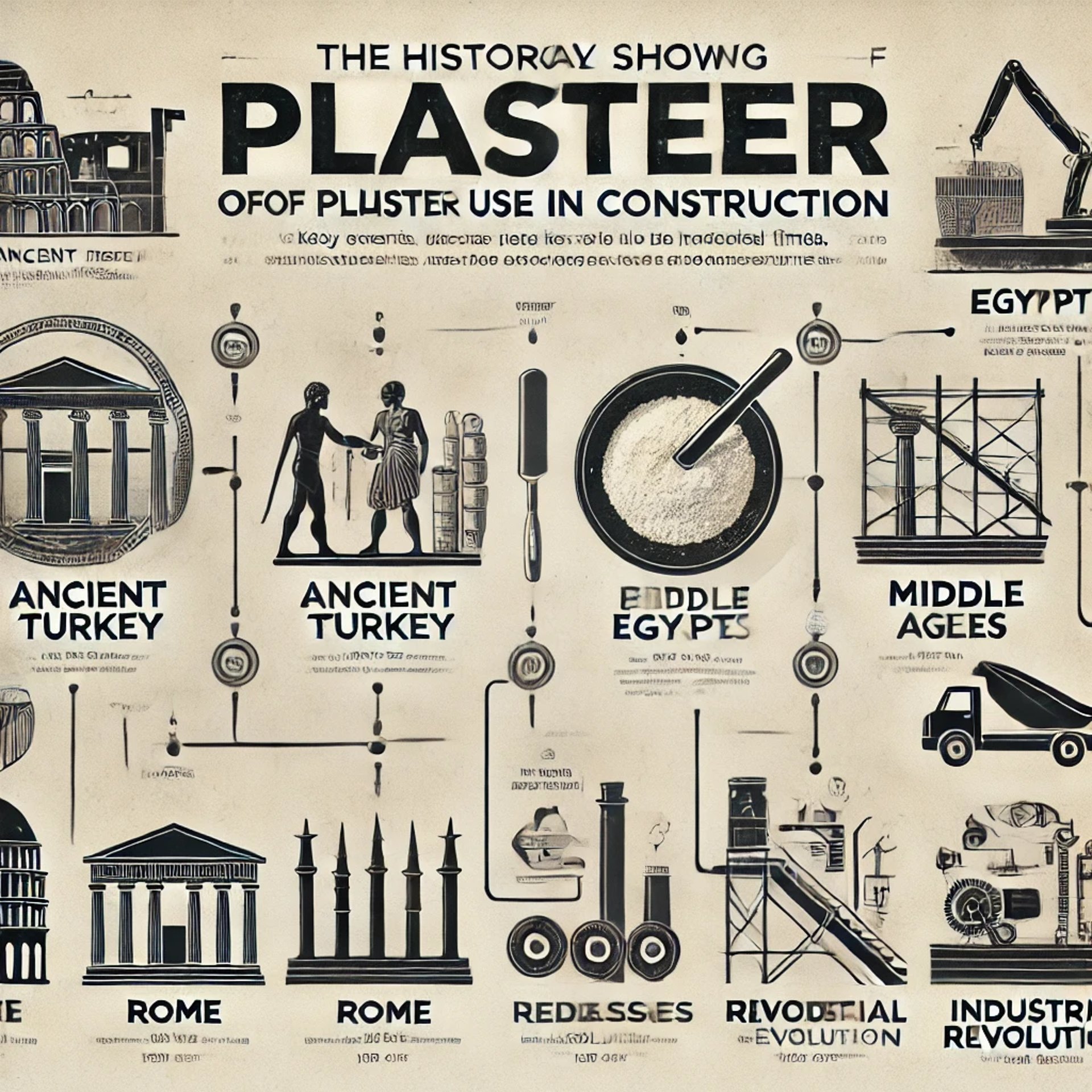
The history of plaster in construction
This article traces the fascinating history of plaster, an essential building material, from its first uses 12,000 years ago to the present day. It describes how plaster was used by ancient civilizations, such as Egypt, Greece and Rome, through the Middle Ages, the Renaissance and the Industrial Revolution, to its modern applications. The article explores plaster's various techniques and evolutions, its many uses, and its role in the creation of decorative and architectural surfaces, while highlighting its durable and aesthetic qualities.
SCIENCE AND TECHNOLOGY
Olivier Houdusse
11/5/20245 min read
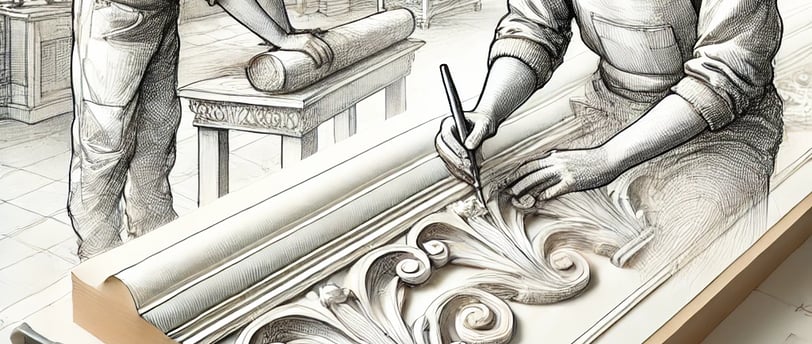

The history of plaster in construction
Plaster has a rich history spanning several millennia, playing a central role in the evolution of architecture worldwide. The first traces of plaster use date back to around 12,000 BC, in the southern regions of Turkey and northern Syria, where it was commonly used to cover fireplaces. (Ancient History Encyclopedia). From the outset, plaster's ability to provide a smooth, durable surface made it essential to everyday life. Over time, its use became more sophisticated, moving from rudimentary domestic applications to complex architectural projects, making it a fundamental material for the development of construction.
Ancient Egypt and the first innovations
In ancient Egypt, gypsum-based plaster played a crucial role in the construction of monuments and frescoes. (Britannica). Gypsum was heated to produce a fine powder, which was then mixed with water to produce a strong, workable material. The Egyptians used it not only as mortar between stone blocks, but also to create smooth surfaces for hieroglyphs and frescoes. The Great Pyramid of Giza and other monuments bear witness to the effectiveness of this material, whose durability enabled decorations to be preserved for millennia. These plaster surfaces were used not only to embellish temples and tombs, but also to tell stories and pass on knowledge.
The use of plaster was not limited to grandiose monuments. It was also present in more modest constructions, demonstrating its practical utility within Egyptian society as a whole. Thanks to its versatility, plaster influenced other civilizations who adopted and adapted this technology to their own architectural needs.
The Greek and Roman eras
The Greeks perfected the use of plaster by introducing stucco, a mixture of lime and sand, which they applied to the exterior walls of temples to add a sophisticated, weather-resistant finish. (Britannica). The Parthenon in Athens is an emblematic example of the use of stucco in Greek architecture, where it was used to enhance architectural and sculptural details. In addition to its structural applications, plaster was used to create sculptures and ornaments, illustrating its versatility and ability to integrate harmoniously into the decorative arts.
The Romans, meanwhile, considerably improved on these techniques. By adding materials such as pozzolan, they discovered that plaster could harden even under water, paving the way for the creation of concrete. (Roman Concrete). This discovery enabled the construction of iconic structures such as Rome's Pantheon, famous for its massive dome and longevity. Plaster was also used in Roman thermal baths, where it provided a smooth, moisture-resistant finish, essential in these public spaces.
The Romans also used plaster to decorate the interiors of villas and public buildings. Frescoes made with pigments mixed with plaster adorned the walls of wealthy homes, depicting scenes from mythology or daily life. These applications helped create sumptuous interior environments, embodying Roman opulence and refinement. These techniques had a lasting influence on Western architecture, laying the foundations for many decorative traditions still visible today.
The Middle Ages and the Renaissance
In the Middle Ages, plaster was widely used in Europe for its insulating and fireproofing properties, as well as for its ease of application. (History of Plastering). Techniques such as “wattle and daub” combined a wooden lattice with a mixture of plaster and other materials to build solid, insulated dwellings. This method was particularly popular in rural areas, offering an economical and practical solution for housing. Plaster was also commonly used in churches to create murals, providing a smooth support that facilitated the work of artists.
During the Renaissance, the use of plaster became more sophisticated thanks to the addition of marble dust, which made it possible to create highly detailed ornaments with a smooth, elegant finish. (Renaissance Plastering). The Doge's Palace in Venice is a fine example of the use of plaster for fine decorative motifs, demonstrating the craftsmanship of the period. Church and palace ceilings were often adorned with stucco, a mixture of plaster, pigments and other materials that added a luxurious, distinguished touch to buildings.
Renaissance plaster also had a structural function. Architects used it to create moldings, cornices and architectural details that added a sophisticated aesthetic dimension to buildings. This period saw the rise of plaster sculpture, enabling artists to push back the boundaries of creativity and create unique works, often influenced by the artistic advances of the period. The development of new techniques marked a milestone in the use of plaster, transforming it into a central material for art and architecture.
The industrial revolution
The industrial revolution transformed the production and use of gypsum thanks to new gypsum processing methods, enabling the production of harder plasters better suited to damp environments. (Construction History Society). The development of fiber-reinforced plaster also facilitated the mass production of complex decorative elements. These innovations popularized the use of plaster in Victorian construction, where plaster moldings and rosettes were synonymous with luxury and refinement.
The industrialization of production made plaster more accessible, enabling it to be used on a large scale in buildings of all sizes. Victorian homes were often adorned with decorative plaster, with details such as cornices and ceiling roses adding a special cachet to interiors. This democratization of plaster made it a popular material for architects seeking to combine aesthetics with reasonable cost.
The development of plasterboard, commonly known as “drywall”, marked a major advance in the construction industry. (Gypsum Association). These boards made it possible to build interior partitions quickly and efficiently, improving the flexibility and speed of construction projects. Gypsum has thus become a key element of modern architecture, offering a practical and aesthetic solution for the creation of interior spaces.
Modern plaster
Today, gypsum remains an essential building material thanks to its versatility and numerous functional and aesthetic qualities. (Modern Plaster). It is used for thermal and acoustic insulation, fire protection and decorative surfaces. Modern types of plaster include Venetian plaster, known for its smooth, glossy finish that lends a touch of elegance, and synthetic plasters, which are more resistant and suitable for a variety of uses.
With renewed interest in sustainable building techniques, lime-based plaster is enjoying a renaissance, not least because of its ability to reduce carbon footprints thanks to its carbon dioxide-capturing curing process. (Green Building Advisor). Contemporary architects such as Renzo Piano use lime-based plaster for its aesthetic and ecological qualities, combining innovation with respect for the environment.
Modern plaster is also prized for its ability to adapt to a variety of shapes, enabling architects and designers to imagine unique spaces. In residential construction, plasterboard is often used to create lightweight partitions and structure interior space. Gypsum is also used in innovative projects to create sensorial spaces, playing with light, texture and sound to offer an immersive experience. These applications show that gypsum is a material with a long history that remains at the heart of the most avant-garde practices in architecture and design.
Conclusion
The history of plaster is one of adaptability and constant innovation. From its beginnings in prehistoric homes to its modern applications, plaster has always been an essential material, offering aesthetic and functional qualities that meet the needs of every era. Its evolution bears witness not only to technological progress, but also to the ability of architects and craftsmen to push back the boundaries of creativity and engineering.
Today, with new demands for sustainability and energy performance, plaster continues to inspire and shape the architecture of the future. It is both a practical material and a means of artistic expression, enabling spaces to be embellished and personalized. Thanks to its ability to evolve and adapt to new trends, plaster will remain a preferred choice for architects and designers seeking aesthetic and sustainable solutions.
Further information
If you're passionate about the history of building materials, we invite you to explore our other articles on green building techniques and the creating sensorial spaces that combine aesthetics and sustainability. Contact us to discuss your projects or find out more about our bespoke services. We'd be delighted to help you incorporate innovative and sustainable solutions into your projects, using materials like plaster to create unique and inspiring spaces.
